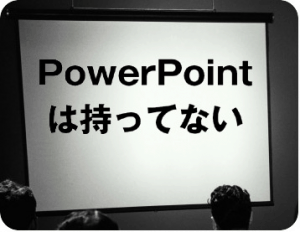Alternative presentation styles: Takahashi
A Takahashi presentation is one of the rising trends in the word of alternative presentation styles. For those trying to push their limits and embrace different presentation styles, it’s a great option for your next speech. The Takahashi method forces you to rethink PowerPoint design, rely more upon speech than slides, and practice your skills of concision and brevity. All these things are great lessons to learn for any presenter. So read ahead to find out how to embrace Takahashi as one of your alternative presentation styles.
What is a Takahashi presentation?
A Takahashi presentation is all about text. It is a technique that uses simple and refined visuals, particularly large block fonts. Named after its creator, Masayoshi Takahashi, the style originated in Japan. A true Takashi presentation doesn’t include any charts, photos or pictures. It only includes words, and only a few on each slide, printed and in large characters. This is an example of one of the alternative presentation styles that use many slides but displays each one for a short period of time. For example, Pecha Kucha similarly focuses on simplicity and brevity. Read our article “What is a Pecha Kucha Presentation?” for more information!
lldecade2012 from masayoshi takahashi
The Takahashi technique started because its inventor never used PowerPoint. Wanting to keep his presentation simple, he summarised the main points of his speech into a few words. They give enough information to guide the audience through the presentation. But the slides also don’t distract from the content. The slides have a similar effect to newspaper headlines. They reel in the readers with something short and snappy before offering further information.
A Takahashi presentation is similar to the Lessig method, which focuses on concision both in time and visuals. Lawrence Lessig, a Harvard professor, wanted speakers to synchronise with the text on their slides. This style also emphasises the power of straightforward text in a presentation.
Why is it popular?
Takahashi presentations became popular in Japan as they help the audience read and understand content rapidly. Other countries speaking eastern languages found it similarly helpful. The non-Latin alphabet often holds more visual meaning, and this presentation style focuses on the optical effect of words.
It became globally popular as presentation trends move towards simplicity and impact. People are quickly realising that bullet points and messy slides do not work. Modern PowerPoints all point towards straightforward text and striking visuals. A Takahashi presentation merges both these qualities perfectly.
The greatness of alternative presentation styles is also being recognised by renowned presenters and authors of successful presentation advice books. For example, Garr Reynolds talks about his experience of Takahashi in one of his Presentation Zen articles.

Takahashi started this style when he didn’t have access to presentation design software. Therefore, it is also adopted by those with limited resources. The ease of creating bold, capturing text means you don’t need any fancy effects or design techniques. All you need it the skills of concision and brevity. Having a confident presenting style makes up for the rest. That being said, many are appropriating the Takahashi style to modern PowerPoint design. And the effect is just as powerful.
Whether you love or hate the Takahashi method, there are many other presentation styles out there to choose. For more examples of different presentation styles, check out this article.
How can I make a Takahashi presentation?
Content and Design
The first and most important step of creating a Takahashi presentation is to organise your content. The actual PowerPoint design won’t take much time. But taking an entire presentation and summarising it in a few conclusive words – that’s the hard part. It’s best to do a bit at a time. First, try summarising your content onto cue cards. This is a practice most presenters are familiar with already. Good speakers don’t often learn their speech word for word as the delivery can sound robotic.
Once you’ve done that, narrow it down a little more. What is a single sentence that summarises each slide? What is the core message you want to portray? Which words are best to explain it? Articulate and then reword to make it a perfect articulation of your point. Then narrow it down a little more. And, if possible, a little more. Once you have a presentation of slides containing only a few words, you’re ready to start designing.
osc2019tokyospring from masayoshi takahashi
Original Takahashi usually just uses a white background with black text. There is no distraction from the content. Although he has also used blue backgrounds with white fonts. And others who have copied his style have also made it their own through different colour combinations. So the choice is up to you. Just don’t be tempted to complicate your PowerPoint design. Remember, this presentation style is all about text.
Once you’ve put your content onto slides, make the font as large as possible. Force it to fill the screen. As long as it still fits, make it as big as possible. Takahashi believes that a huge font embeds itself on the memory of the reader. It is true that audiences are less likely to focus on text if it is small and a lot.
Presentation Technique
The final stage of creating a Takahashi presentation is practice. For any good speaker, the slides should be there to support you, not carry you. But with this style, there is hardly anything to distract the audience from you, your words and your presenting presence.
It is more important than ever to keep your speech consistent with the slides. You want the text to be summarising what you are saying. This will make the most impact and instil the message into the audience. You will also need a larger number of slides than usual to conceptualise your whole presentation. Confidence in knowing when the switch to the next point will make this flow all the more impressive. So practice repeatedly until your presentation is perfect.
If you need some inspiration, check out this video of Masayoshi Takahashi himself presenting. Although it is in Japanese, you can still appreciate the style of his presentation and the synchronisation between slides and speech.
Different presentation styles come in all shapes and sizes. The Takahashi method is particularly captivating due to its intense simplicity. It takes a certain bold confidence in the presenter. And that comes across in the visually bold and confident text. If you are trying to push your presentation limits or find a simpler method of slide design, jump on the trend of the Takahashi presentation!




